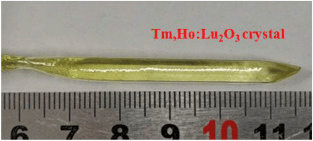Sep 23 2019
For many decades, 2-μm lasers based on Tm3+-Ho3+ co-doped host media have garnered a great deal of attention in free-space optical communication, light detection and ranging (LIDAR), laser microsurgery, atmospheric sensors, and free-space optical communication.
 The as-grown Tm,Ho:Lu2O3 crystal. (Image credit: SIOM)
The as-grown Tm,Ho:Lu2O3 crystal. (Image credit: SIOM)
It has been demonstrated that Tm3+-Ho3+ co-doped crystals are the best gain-media working at 2 μm. This claim was attributed to the efficient energy transfer and cross-relaxation process.
A wide range of Ho3+ and Tm3+ co-doped hosts has been developed in a previous study. Rare-earth cubic sesquioxide crystals are considered as one of the most remarkable products with low maximum phonon energy and high transmittance.
Given the doping on thermal conductivity, Lu2O3 is the most popular one for its comparable mass of the doping ions. Owing to the reasons stated above, Ho3+ and Tm3+ co-doped LuLu2O3 crystal (Tm,Ho:Lu2O3) can be a potential material for 2-μm lasers. Yet, a very high melting point as well as considerable difficulties of crystal preparation tends to pose challenges.
In the recent past, a collaborative group from Shanghai Institute of Optics and Fine Mechanics of the Chinese Academy of Sciences, along with Guangxi University, has developed a novel preparation process to grow Tm,Ho:Lu2O3 crystals. The optical and structural characteristics were systematically examined. The study outcomes have been published in Optical Materials.
Now, using the optical floating zone technique, scientists have achieved the high-quality 5 at.% Tm, 0.5 at.% Ho:Lu2O3 crystal for the first time. Measuring ∅4x36 mm3, the crystal does not contain any crack or bubble.
During the experiment, perfect doping ability was exhibited by the Lu2O3 host since the segregation coefficients of Tm3+-Ho3+ ions were respectively 0.70 and 0.94. This was performed by inductively coupled plasma atomic emission spectrometry analysis.
Up-conversion experiments were also performed to obtain complete data on the dynamics of the excited states. Moreover, the energy transfer process between Ho3+:5I7 and Tm3+:3F4 energy levels was reversible to a quasi-detailed balance; hence, the lifetime of Tm3+:3F4 manifold also had an impact on the lifetime of Ho3+:5I7 energy level in the equilibrium state.
This may elucidate the fact that the 2-μm emission’s fluorescence lifetime decreased in Tm3+-Ho3+ co-doped crystals. The study provided an effective preparation process for crystals with very high melting point and created a new gain medium for 2-μm lasers.
The National Natural Science Foundation of China, the National Key R&D Program of China, Strategic Priority Research Program (B), and the Major Project of Shanghai Science and Technology Research Foundation supported the study.